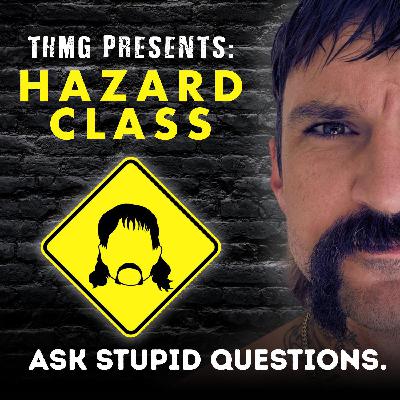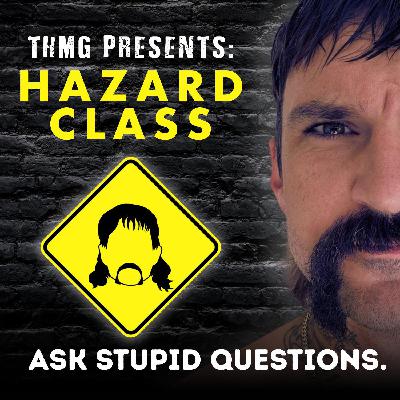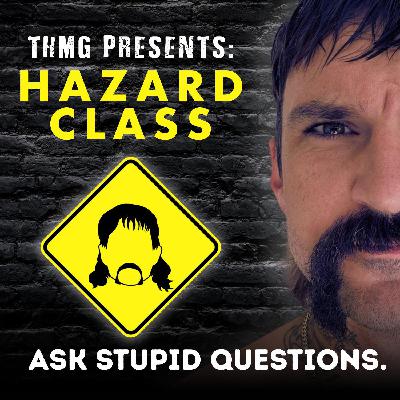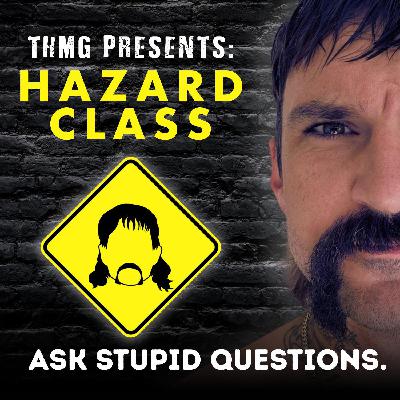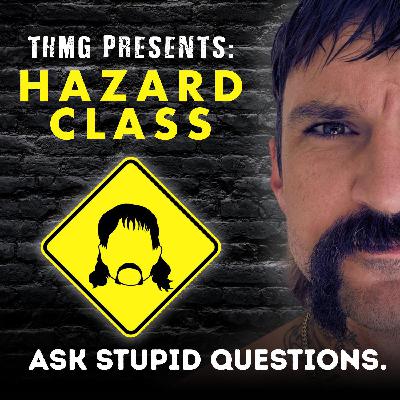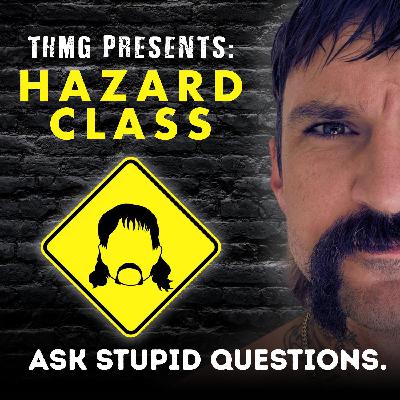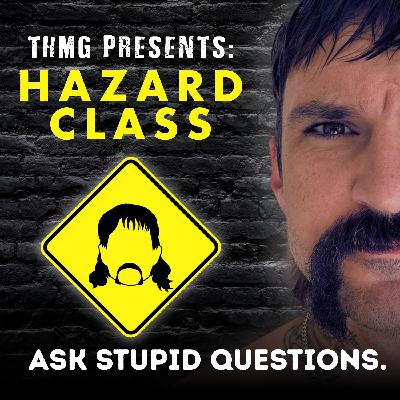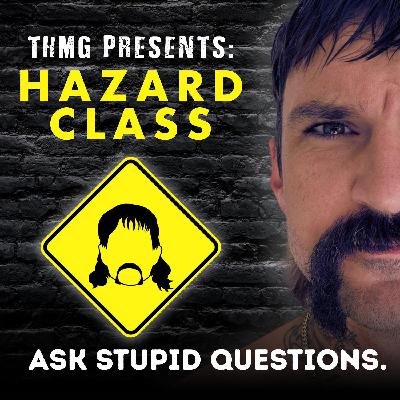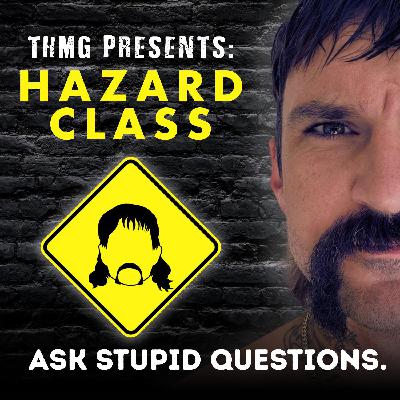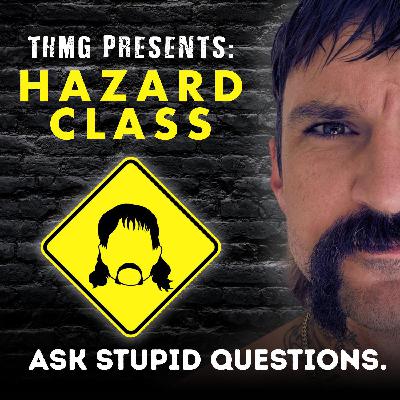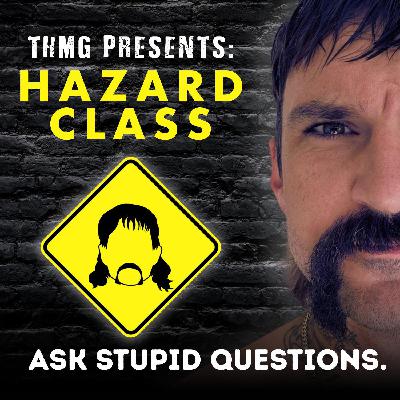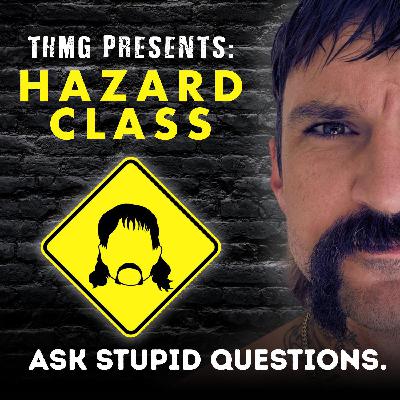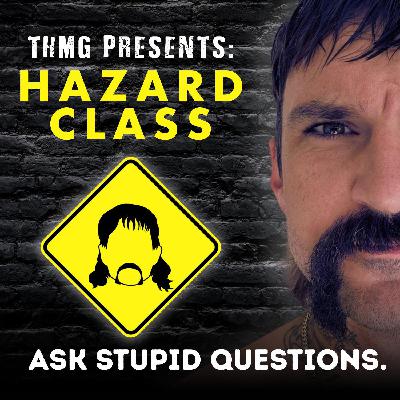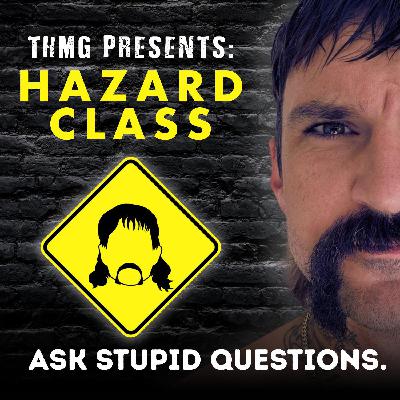Discover HAZARD CLASS
HAZARD CLASS

HAZARD CLASS
Author: Jake Ryks
Subscribed: 5Played: 78Subscribe
Share
© Jake Ryks
Description
HAZARD CLASS is the podcast where the curiosity of genuine questions in and around the world of emergency services is met with the knowledge of leading experts in their fields. Our intention is to bring YOU to “the firehouse table” where the rookie meets the senior man and they share knowledge through genuine conversation.
54 Episodes
Reverse
This explosive episode dives into the story of Erik Holt, a former fire chief fired after reporting alleged election fraud—an election that installed the very board that terminated him. From military service and firefighting to confronting corruption, Holt walks us through his journey, decisions, and consequences.LINKS:https://www.gofundme.com/f/free-speech-retaliation-and-the-cost-of-integrity https://www.facebook.com/justiceforholt/Segment Breakdown & Timestamps:[0:00:00] Origins in Fire ServiceErik recounts his start in emergency services, high school recruitment, army firefighting in Iraq, and career progression in Colorado.[0:10:00] Becoming Fire Chief & Rebuilding a DepartmentTaking the helm in 2022, Erik discusses the chaos he inherited and his success in rebuilding a rural department—cutting response times from 19 to 7 minutes and increasing qualified responders from 4 to 62.[0:20:00] The Election SetupHe details the special district board’s structure and how all five seats unexpectedly opened for election—introducing a slate of opposition candidates.[0:30:00] Election Day AnomaliesErik responds to complaints about the election. He later reviews hours of surveillance footage (which anyone could legally access), discovering a pattern of coordinated, likely illegal poll watcher behavior and vote tracking.[0:40:00] The Scheme UnfoldsEvidence emerges of pre-counting ballots, illegal electioneering, and poll watchers using clickers to track compliant voters. The alleged “offsite coordinator” turns out to be the campaign manager’s husband.[0:50:00] Retaliation BeginsDespite no operational or disciplinary issues, Erik receives dubious orders—like disabling security systems—and the new board freezes fire department bank accounts just before a holiday weekend.[1:00:00] Fire Department Shut DownErik is ordered to shut down operations despite the insurance bill being paid. The board blames him, leading to a four-hour service disruption and massive public fallout.[1:10:00] Public Smear & TerminationDespite not controlling finances, Erik is fired under the pretext of “not paying insurance.” The event is turned into a bizarre celebration by the board with popcorn and lemonade.[1:20:00] Legal Fallout & Personal CostErik files a federal lawsuit (currently under appeal). Blackballed from firefighting, he loses his home and lives in a camper with his daughters while fighting to clear his name.Key Moments:Erik's rebuilding of a failing fire district into a professionally functioning agency in less than a year.Discovery of illegal poll watcher behavior including vote tracking and ballot manipulation.Board’s retaliation including bank account freezing and misuse of authority.Shocking termination under false pretense just 33 days after whistleblowing.Resources & References:Video evidence and court filings shared by Erik on his social media accounts.Colorado election statutes and open records laws (CORAs).Lookup: “Florrissant Fire Muster” for footage of the department’s final major public event.Guest Bio:Erik Holt is a former Army firefighter and veteran of Iraq, former chief of a Colorado fire district, and a whistleblower involved in an ongoing legal and public battle over local election integrity.
In this episode of the Hazard Class Podcast, we sit down with Deputy Chief Daniel DeYear, a 45-year veteran of the fire service, including notable positions such as U.S. Department of State Fire Marshal and Deputy Chief of Dallas Fire Rescue. In a candid conversation, Chief DeYear shares stories from his extensive career, including his early days in the fire service, the evolution of EMS and fire tactics, and the importance of training and accountability in today's fire departments.00:00 - Introduction to Chief Daniel DeYearIntroduction of Chief DeYear and his illustrious 45-year career in the fire service.Overview of his roles in Dallas Fire Rescue and as an international fire marshal with the U.S. Department of State.02:00 - Early Days in the Fire ServiceChief DeYear reflects on his upbringing in the Bronx during the 1960s and 70s, and how he was drawn to the fire service from a young age.Becoming a junior volunteer firefighter at the age of 14.The early influence of the Emergency! TV show and Dennis Smith's Report from Engine Company 82.05:30 - Firefighting in the 70s and 80s: Primitive Tools and CommunicationDescription of early fire gear, including 15-minute SCBAs, and the lack of radios for firefighters.A look at the culture of firehouse accountability before formalized systems were introduced.Chief DeYear's early experiences with dangerous fires, such as the incident where he helped rescue a firefighter trapped under a collapsed beam at the age of 15.09:40 - Realizing the Fire Service Was the Career PathChief DeYear talks about his decision to pursue firefighting as a lifelong career and how his family supported his path despite their initial reservations.The competitive job market in the fire service at the time and his journey to becoming a firefighter in Texas.14:00 - Transition to the Dallas Fire Department and Working as a Fire MarshalChief DeYear’s move to Texas and his time at the Carrollton Fire Department.His work as a Fire Marshal, public educator, and later, a training officer.His time as an international fire marshal and what that role entailed while traveling to over 35 countries.22:00 - The Evolution of EMS and ParamedicineEarly days of EMS in the U.S. and Chief DeYear’s experience as a paramedic in the early 80s.28:00 - Fire Tactics and Safety: A Changing LandscapeDiscussing the evolution of fire tactics, including changes in firefighting gear, communication, and building construction.The shift from traditional fire tactics to more advanced practices, including better understanding of fire science and building construction.34:00 - The Role of Company Officers and LeadershipChief DeYear’s thoughts on what makes a good company officer in the fire service.The importance of mentorship, investing in the crew, and avoiding complacency.43:00 - Line of Duty Deaths and Safety CultureChief DeYear reflects on his experiences with line of duty deaths and the fire investigations that shaped his perspective on safety.The importance of assessing risk versus reward and the need for smart decision-making on the fireground.50:00 - Training and Improving the Fire ServiceThe value of continuous training, even after years of service, and the importance of self-assessment.Chief DeYear’s thoughts on how to cultivate a training culture that embraces learning, even among experienced firefighters.1:00:00 - Handling Critiques and Learning from MistakesChief DeYear discusses how to properly handle post-incident critiques without turning them into punitive sessions.The importance of balancing positive reinforcement with constructive feedback in fire department training.1:05:00 - Chief DeYear’s Advice for Young FirefightersThe role of company officers in shaping the career trajectories of young firefighters.How to guide rookie firefighters and ensure they remain engaged and passionate about their work.
In the Season 2 premiere of the Hazard Class Podcast, Jake sits down with John Esposito, Chief of Department for the FDNY, for an intimate and wide-ranging discussion on leadership, legacy, and the realities of life in one of the world’s busiest fire departments. From 9/11 reflections and the evolution of FDNY to the traits of impactful leaders and memorable fireground moments, Chief Esposito shares hard-earned wisdom and never-before-heard stories that offer rare insight into the heart of New York’s Bravest.0:00 – 2:45 | Intro & 9/11 ReflectionsJake introduces Chief Esposito and shares a personal 9/11 memory.Chief discusses how 9/11 reshaped the FDNY and the lasting impact on the department’s culture and capabilities.2:46 – 6:00 | The FDNY’s National InfluenceHow FDNY’s decisions ripple across the American Fire Service.Lessons learned through innovation and trial by fire.6:01 – 12:00 | Staying Connected to the StreetsChief Esposito explains how he maintains real-time awareness of field operations.Insights on technology, communication systems, and his use of Citizen App.12:01 – 14:26 | Origins & Career BeginningsWhy Esposito joined the FDNY in 1991.Reflections on becoming a firefighter and the influence of Report from Engine Co. 82.14:27 – 18:00 | First Fire & Early LessonsVivid recollection of his first fire.Thoughts on preparation, performance, and the emotional charge of that first job.18:01 – 21:15 | Transition to Special OperationsMoving to Squad 18 and working with elite fire personnel.The rigorous process and mindset behind making the switch.21:16 – 25:35 | Training Culture & Tough CallsThe philosophy of consistent, adaptive training.Real-world example: A Bronx rescue where plan B wasn’t good enough—they needed plan E.25:36 – 30:04 | Memories of Andy FredericksPersonal stories and heartfelt tribute to a fire service legend.A hilarious and humbling hydrant mishap involving Fredericks.30:05 – 33:25 | Climbing the RanksPost-9/11 promotions and unexpected career trajectory.How staying ready allowed him to rise in leadership.33:26 – 36:32 | Leadership & MoraleThe most important traits in fire service leadership.Balancing empathy, accountability, and understanding your people.36:33 – 38:08 | Caring for MoraleWhere morale comes from and how leaders must foster it.Real-life examples of FDNY’s finest doing heroic work.38:09 – 40:00 | Pride & PurposeWhat Chief Esposito is most proud of in his career.Doing the right thing in gray-area decisions.40:01 – 41:21 | The Stupid Question ReturnsOG question: Who would win in a fight—grizzly, tiger, or gorilla?Fun and lighthearted close with reflections on strength and instinct.Segment Breakdown & Timestamps:
In this compelling episode, Jake is joined by Lt. Col. Quinn Gallagher, a veteran U.S. Air Force pilot with nearly 20 years of service. Gallagher's story is one of deep personal loss, resilience, and unwavering dedication to preserving life—both on and off the battlefield. From harrowing combat rescue missions in Afghanistan and Iraq to evaluating cutting-edge aircraft as an experimental test pilot, Quinn shares a raw and insightful look into military aviation, emotional endurance, and the pursuit of purpose through service.Segment Timestamps:00:00 – Introduction and Guest WelcomeJake introduces the episode and welcomes Lt. Col. Quinn Gallagher to the show.06:51 – Wheel of Stupid Questions: Can You Beat a Cheetah?Kicking things off with a humorous debate about whether Quinn could beat a cheetah in a fight.13:42 – Quinn's Childhood and Motivation for ServiceQuinn recounts early childhood experiences that sparked his desire to serve others.20:34 – Tragedy and Early Exposure to LossHe shares tragic events that shaped his understanding of life and death from a young age.27:25 – Firefighting vs. Military – Career CrossroadsExploring the decision between firefighting and joining the military.34:17 – Path to the Air Force AcademyHow Quinn got into the Air Force Academy, including a unique presidential nomination.41:08 – Air Force Training and Vision WaiversDiscussion of the challenges and special accommodations needed to become a pilot.48:00 – Flight Training and Choosing HelicoptersAn inside look at military flight school and why Quinn opted to fly helicopters.54:51 – First Combat Deployment: AfghanistanStories from Quinn’s first deployment in Afghanistan and his early combat missions.61:43 – Crew Composition and Helicopter OperationsDetails about helicopter crew roles, mission dynamics, and technical aspects of flying.68:34 – SERE School and Mental PreparationInsights into SEER training and how it prepares pilots for survival and resistance.75:25 – Second and Third Deployments: Iraq and AfricaOperations in Iraq and Africa, comparing the intensity and mission scope.82:17 – Test Pilot Work and Evaluating AircraftGallagher's role as a test pilot and what it’s like evaluating advanced military aircraft.89:08 – Reflections on Service and Returning HomeQuinn reflects on combat, mental health, burnout, and transitioning to civilian life.
The Hazard Class Podcast takes a step back to reflect on one year of podcasting. Celebrating the show's first anniversary, he shares behind-the-scenes insights, the journey so far, mental health milestones, and exciting future directions. This episode offers a rare, personal look into the making of the podcast, the powerful impact of its guests, and what’s ahead—including a few intriguing curveballs like Bigfoot and ghost hunters.Segment Breakdown & Timestamps[00:00] Welcome & IntroductionReflecting on the anniversary and how it all began.[01:30] Gratitude to Listeners & GuestsExpressing deep appreciation for the audience and highlighting iconic guests like John Norman, Dennis Lagear, Ray McCormick, and Coralie Moore.[04:50] Podcast Milestones & Guest HighlightsA recap of some standout moments and interviews from the past year.[07:10] Mental Health JourneyPersonal update on visiting the IAFF Center of Excellence and how it’s impacted his life and the podcast.[09:25] Current Challenges & Behind-the-ScenesDiscussing the grind of weekly production and the realities of running a podcast solo.[11:10] Upcoming Fire Fusion Conference & Medal of ValorSharing the honor of receiving a national award and traveling to Charleston, SC.[14:00] Mason’s Deployment & Team AcknowledgmentRecognizing his colleague Mason, currently deployed, and emphasizing the team effort behind the recognition.[16:30] Life Updates & Lighter MomentsTalking about kayaking with dolphins, crocodile paranoia, and keeping the tone light and fun.[18:30] What’s Next for the PodcastPlans to diversify guest topics including Bigfoot, aliens, and ghost hunters. A sneak peek into a curious and expanded vision for future episodes.[21:00] Closing Remarks & Thank YouA sincere thank-you to listeners and encouragement to continue supporting the show.Key Moments & Highlights“Never in my wildest dreams did I think I'd talk to these people.” – A moment of humility reflecting on conversations with industry legends.Honest insight into the emotional and logistical challenges of independent podcasting.Teaser for future content: From hazmat to the paranormal—because it’s his podcast, and he’ll do what he wants.As the Hazard Class Podcast wraps its first year, this episode offers gratitude, reflection, and a preview of what’s next. From tactical insights to unexplored curiosities, the host promises to keep conversations meaningful and the content evolving.Enjoyed the episode?Subscribe on your favorite podcast appShare it with friends and colleaguesFollow us on Social MediaLeave a review – it helps more than you knowThank you for an incredible first year. Here's to many more.
In this episode, we welcome Chief Corley Moore, retired battalion chief, author, podcaster, and the mind behind Firehouse Vigilance. Known for his thought leadership in fire service culture, leadership development, and his popular “Weekly Scrap” podcast, Corley shares his personal journey from a young father working dead-end jobs to becoming a leader and voice in the fire service.This episode is packed with relatable stories, valuable leadership principles, reflections on organizational culture, and a deep dive into the importance of training, humility, and continual growth within the fire service.Segment Breakdown & Timestamps:0:00 – 1:04 | Introduction & Guest WelcomeIntroduction to Chief Corley Moore, his background, and work with Firehouse Vigilance.1:05 – 3:37 | Wheel of Stupid QuestionsCorley reveals his nerdy side, including his love for sci-fi, D&D, and 80s fantasy trivia.3:38 – 10:48 | Corley’s Firefighting Origin StoryFrom marrying young and raising three kids by 23 to joining the fire service by chance, Corley shares how he found his calling.10:49 – 18:28 | Early Career & Moore FD CultureWhat the Moore FD was like in the late ‘90s, from frat-house vibes to a lack of training, and the slow shift toward professionalism.18:29 – 25:49 | The Culture Shift & Value of TrainingCorley recounts the challenges and triumphs in shifting from complacency to a culture of excellence—and how training became the cornerstone.25:50 – 33:03 | Leadership Journey & Writing ProcessCorley discusses his passion for leadership, the origins of his “Nine L’s,” and how laying tile taught him to write books.33:04 – 37:11 | First Fire & Lessons LearnedCorley recalls his first real fire, the adrenaline, the mistakes, and the lessons about preparedness and training.37:12 – 44:00 | Promotions, Growth, and Self-AssessmentReflections on career transitions—from firefighter to driver, to company officer, and eventually to BC—plus what skills matter at each step.44:01 – 59:28 | Leadership Standards & Culture CreationDeep dive into setting expectations, accountability, and servant leadership—plus the challenge of promoting healthy firehouse culture.59:29 – End | Staying Engaged, Building Impact, and Final ReflectionsHow high-performing leaders stay motivated, the role of conferences, and why expectations at the top determine performance at the bottom.Resources & References:Corley Moore’s Work:Firehouse Vigilance WebsiteThe Nine L’s of Leadership – BookWeekly Scrap Podcast: Interviews with fire service leadersAbout the Guest – Chief Corley Moore:Chief Corley Moore is a retired battalion chief from the Moore Fire Department in Oklahoma, with over 28 years of service. He is the founder of Firehouse Vigilance, host of the Weekly Scrap podcast, and author of The Nine L’s of Leadership. His mission is to fight complacency and raise the standard of fire service culture through training, accountability, and meaningful leadership.
In this powerful and emotionally charged episode, the host sits down with Josh Shores, a Marine Infantry Combat Veteran, Purple Heart recipient, retired firefighter, and author of the raw and gripping memoir "Counting on Death." Together, they explore Josh's harrowing experiences during the Iraq War, his emotional return to civilian life, his time in the fire service, and his long journey through trauma, identity, and healing.Whether you're a veteran, a first responder, or someone seeking to better understand the impact of trauma and the path to recovery, this episode offers profound insights and a deeply human story of perseverance.Segment Breakdown & Timestamps:0:00 – 1:31 | Introduction & Guest Welcome Introduction to the podcast and guest Josh Shores, highlighting his military service and new book Counting on Death.1:32 – 5:49 | Writing Through Trauma Josh discusses how the book started as cognitive therapy and eventually became a published work despite pushback for its raw content.5:50 – 8:50 | Writing for Self vs. Audience The discussion explores how writing for himself allowed Josh to dig deeper emotionally and share more honestly.8:51 – 12:51 | Counting on Death & Mental Weight of War Josh expands on a haunting line from the book and explains how unclear missions and moral ambiguity left deeper scars than combat itself.12:52 – 15:08 | Who Should Read This Book? Josh articulates the book’s purpose: as a tool for veterans and first responders to help others understand what they can’t say aloud.15:09 – 19:51 | Humor, Irony, and the Bonds of War A humorous anecdote about a malfunctioning rifle leads into a broader reflection on the camaraderie and absurdity found in war.19:52 – 23:08 | From Warfighter to Firefighter Josh shares his transition to the fire service, drawing parallels between combat and firefighting, and the eventual emotional and physical toll.23:09 – 26:39 | Injury, Advocacy & Departure from the Fire Service A serious injury and lack of institutional support led Josh to leave the fire service. He reflects on loss of identity and resilience.26:40 – 29:33 | Judgment & Misconceptions The hosts reflect on how people misunderstand mental health struggles and the fire service’s rumor mill.29:34 – 36:06 | Mental Health in High-Stress Careers A candid conversation on therapy, the compounding stress of first responder life, and the generational shift toward addressing mental health.36:07 – 44:40 | Parenting, Perspective, and the Fragility of Life Josh reflects on fatherhood, the importance of patience with children, and how his exposure to death reshapes his everyday decisions as a parent.44:41 – End | Final Reflections & Where to Find the Book Josh shares the core hope behind his book: helping others understand the mental toll of trauma and how to open conversations around it.Resources & References:Counting on Death: A Marine Infantryman’s Journey from the Frontlines of Combat to the Fight for Peace Available on:AmazonBarnes & NobleAudibleCasemate PublishersPodcast Mentioned:Nomadic Research Podcast with Dagan Van Oosten – an in-depth discussion on the book and Josh’s experiences.About the Guest – Josh Shores:Josh Shores is a Marine Corps infantry veteran with combat deployments to Ramadi, Iraq, and Afghanistan. After military service, he became a firefighter, only to later leave due to a debilitating injury and the emotional toll of accumulated trauma. His memoir Counting on Death is a candid, unfiltered look at war, loss, healing, and resilience.Concluding Summary & Call to Action:Josh’s story is a raw testament to the unseen battles faced by veterans and first responders. His courage to share openly creates a space for others to find language for their own pain and paths to healing.Subscribe to the podcast, share this episode, and continue the conversation around mental health, trauma, and recovery.
In this episode of the Hazard Class Podcast, Jake talks with Eric Guida, a retired Fire Captain from Sacramento Fire Department and now Sales Director at HEN Nozzles. With more than 30 years of experience, Eric opens up about his early inspirations, firefighting culture, leadership lessons, and why the future of fireground safety lies in innovation. It’s a candid conversation bridging tradition and technology, with advice that resonates far beyond the firehouse.Segment Breakdown & Timestamps(0:00–1:13) – Welcome & Guest IntroHost introduces Eric Guida and gives context to his 30-year career and current role with HEN Nozzles.(1:15–3:20) – Wheel of Stupid Questions: Talking DogsEric shares a lighthearted moment about the one animal he’d want to talk to if he could—his family dog.(3:20–12:44) – From Vet School Dreams to Fire Service RealityEric recounts his unexpected journey into firefighting, including a pivotal moment with a bottle of ouzo and a phone book.(12:45–17:47) – Adjusting to Big City FirefightingFrom Fair Oaks to Sacramento, Eric discusses the cultural shift, increased call volume, and lessons from his early mentors.(17:48–20:36) – When Firefighters Should Start Speaking UpExploring leadership from the backseat and the reality of who gets heard—and why.(20:37–27:03) – Promotion, Influence & the Value of IdeasEric reflects on his motivation to promote and the challenges of filtering good ideas in a data-driven world.(27:04–30:39) – Engine Company Ops: What's Being Missed?Advice on fundamentals: line deployment, water application, and the importance of not rushing at the cost of effectiveness.(30:40–36:18) – Captain Lessons: If I Knew Then What I Know NowEric shares what he would tell his newly promoted self about finding rhythm, style, and staying adaptable.(36:20–39:20) – Combating Pride in the Fire ServiceThe importance of humility and asking questions, and why firehouse culture must be safe for learning.(39:22–42:15) – Saying Goodbye: The Reality of RetirementAn emotional look at transitioning out of the fire service and what Eric misses the most about the job.(42:15–46:08) – Firehouse Marriage Advice from 37 YearsEric offers wise and empathetic advice on marriage, parenting, and showing up at home while serving the public.(46:08–50:59) – Joining Henn Nozzles: From Retirement to ReinventionA LinkedIn message leads to a second career helping shape the future of firefighting tools.(50:59–56:43) – The Bladed Stream: Rethinking the Fire NozzleEric explains the science and field testing behind Henn’s groundbreaking nozzle design.(56:43–End) – What’s Next for Henn & A Mission to Give BackNew innovations, expanding reach, and Eric’s drive to make the fire service safer for the next generation.Key Moments & Insights“You can lead from all rungs of the ladder.”“Fail in training, not on the fireground.”“I wasn’t looking to retire—but it was time.”“This is the best firefighting nozzle ever made.”Guest Info: Eric GuidaFormer Role: Fire Captain, Sacramento Fire DepartmentCurrent Role: Sales Director, Henn NozzlesCareer: 30+ years in fire service
Jake sits down with Tanner Shipman, a seasoned law enforcement officer from Anoka County, Minnesota, who recently received national acclaim for his courageous actions while off duty during a gunfight in Sturgis, South Dakota. With 20 years of service under his belt, Tanner recounts the harrowing incident that earned him multiple "Officer of the Year" honors and reflects on his career, the evolving landscape of policing, and the deeply personal impact of that life-altering day.Segment Breakdown with Timestamps:0:00 – Introduction & Guest Bio Meet Tanner Shipman: 20-year veteran, former FTO and apprehension deputy, two-time Medal of Valor recipient, and recent awardee for his off-duty heroism.1:10 – The Jiu-Jitsu Champion Tanner shares a lighthearted take on his recent jiu-jitsu victory and competing in the "Masters 4" division.2:36 – Stupid Question Tradition Jake asks: “Who would play you in the movie of your life?” Tanner's answer adds a humorous start to the episode.3:35 – Why Law Enforcement? Tanner talks about growing up in Anoka County and how a high school tour of a jail sparked his interest in law enforcement.6:45 – Career Path & Early Struggles Details about Tanner’s unconventional path to becoming a deputy, including setbacks and working his way through tech school.9:00 – The Realities of Field Training An inside look into the phases of field training and the “dog watch” night shift experience.11:15 – Anoka County Demographics An overview of the county Tanner serves: size, structure, and how deputies are assigned.13:00 – The Evolution of Policing How societal changes since 2014 have affected law enforcement recruitment and morale.15:15 – Body Cams & Public Perception Tanner discusses the pros and cons of body cameras and the importance of context in interpreting footage.18:00 – Misconceptions About the Job He shares how the public often underestimates the complexity and emotional intensity of law enforcement.20:30 – Building Trust with the Community The role of citizens' academies and reserve programs in improving public understanding.Key Segment: The Sturgis Gunfight (22:30 - 51:00)Tanner recounts the harrowing moment he intervened in an active shooter situation while off duty in Sturgis, South Dakota:Witnessing a trooper in a gunfightRunning unarmed toward dangerUsing his sister-in-law’s handgunEngaging the suspectProviding emergency medical aidEmotional aftermath with his familyThis is a powerful, moment-by-moment retelling of bravery, faith, and instinctive action under life-threatening circumstances.Emotional Aftermath & Reflections (51:00 – End)51:00 – Processing the Event Tanner discusses the emotional toll on himself and his family and the unexpected waves of trauma post-event.54:30 – Public Recognition & Awards How the law enforcement community responded, and what it felt like to be celebrated for something he considered simply “the right thing to do.”58:00 – Philosophical Reflections A thoughtful discussion about good vs. evil, humanizing both the badge and the people law enforcement serves, and what true service means.Key Moments & Quotes:“There was no hesitation. I knew I had to act.”“Wouldn’t any cop do that?” — a question Tanner asks himself until others tell him, “No, not everyone would.”“Even these people... the only thing they’re left with is their dignity.”
In this episode of the Hazard Class Podcast, we chat with Bobby Salvesen, a retired FDNY Hazmat One member, co-founder of the Hazmat Guys, and former ultramarathon runner. Bobby shares his journey from growing up in Levittown, NY, to becoming a leading hazmat instructor. He discusses his time in FDNY, the origin of the Hazmat Guys podcast, and his passion for educating others in hazmat operations.In this episode, Bobby discusses:[2:06] – Wheel of Stupid QuestionsAI’s future and whether it could become sentient and destroy humanity.[5:52] – Bobby’s Origin StoryGrowing up in Levittown and his love for running, which shaped his competitive mindset.[8:49] – Early Firefighting DaysJoining the fire service at 18, and transitioning from EMS to FDNY.[11:39] – Joining FDNY and Special OperationsHis transition to FDNY, becoming part of Special Operations after 9/11.[23:19] – Moving to Hazmat OneHis move to Hazmat One after 12 years with Squad 288 and leveraging his chemistry degree.[26:08] – The Beginning of Hazmat GuysHow the Hazmat Guys podcast started and the challenges of building a hazmat education platform.[31:22] – Teaching and MentorshipBobby’s journey into teaching, from training officer in the volunteer fire service to FDNY's department-wide instructor.[37:37] – The Future of Hazmat GuysUpcoming projects and collaborations with states and countries.[40:39] – Hobbies and Life Outside of HazmatHis involvement in ultramarathons, owning a trophy shop, and competitive bagpiping.[43:27] – Looking Back and Looking ForwardBobby’s reflections on his career and his excitement for the Southern Most Hazmat Conference.Follow us on Social Media.Subscribe and Review:If you enjoyed today’s episode, please leave us a review on Apple Podcasts or Spotify.
In this episode of the Hazard Class Podcast, Jake sits down with Mike Monaco—co-founder of The Hazmat Guys, retired FDNY Hazmat One specialist, and one of the leading hazmat instructors in the world. From growing up in Texas and ballet studios to battling dyslexia, his experience during 9/11, and building a global hazmat education platform, Mike shares his remarkable story. Along the way, we dive into personal quirks, firehouse culture, hazmat training, and the unexpected path that led to starting one of the most impactful hazmat podcasts out there.This conversation is equal parts funny, raw, and inspiring—and yes, it begins with a 10-minute debate on the “right way” to wipe.Episode Breakdown with Timestamps[0:00] – Welcome & IntroductionHost sets the stage: why this show is about the people behind the uniform.Introduction of guest Mike Monaco and his reputation as a brilliant instructor, terrible speller, and all-around great guy.[4:15] – The Wheel of Stupid Questions (Bathroom Debate)Standing vs. sitting: the age-old wiping debate.Cultural shame, bidets, and why “rub, squirt, rub” might just be the ultimate method.A lighthearted (and hilarious) start that reveals Mike’s humor.[14:00] – Mike’s Early Life & BackgroundGrowing up in Tomball, Texas before moving to New York.German roots, Italian family culture, and a childhood spent in ballet studios.His mother’s career as a ballet dancer with the American Ballet Theatre.Battling dyslexia, ADHD, and defiance disorder in school.How Catholic school and a switch in majors got him through education.[28:45] – College, 9/11, and the FDNY PathStudying chemistry, physics, and ultimately biology/neurophysiology at Stony Brook.Volunteering in the fire service during college.His 9/11 experience as part of Northern Brookhaven Tactical Rescue, working at Ground Zero for a week.Joining the FDNY less than a year later (July 2002).[40:30] – Hazmat One: Baptism by FireTransitioning from Engine 233 in Brooklyn to Hazmat One.The house culture post-9/11 and tensions between Hazmat and Squad 288.The grueling spin-up process: 1,500+ hours of training and equipment sign-offs.Why hazmat techs often know more than incident commanders—and the responsibility that carries.[55:10] – Teaching, Learning, and the Origin of The Hazmat GuysWhy teaching is the best way to learn in hazmat.How Bobby pitched the idea of a hazmat podcast.The first “atrocious” recordings in the dining room.Turning real-world calls into podcast episodes.When they realized people were actually listening—and recognizing them at conferences.[1:08:30] – Growing Beyond the PodcastMoving from podcast to training and conference teaching.Building a global hazmat education brand.Balancing passion for firefighting with the career opportunities hazmat provided.[1:19:00] – The Future: Training, Conferences, and GamesPlans for The Hazmat Guys: podcasting, training, books, and the new Hazmat board game.Preview of the upcoming Southernmost Hazmat Conference in Key West.How they’re rethinking conferences to integrate vendors, hands-on training, and student engagement.[1:30:00] – Closing ReflectionsMike’s pride in building something bigger than himself.Host and guest share laughs about ballet, dyslexia, and life lessons.
In this episode, we explore cutting-edge research aimed at tackling one of the leading causes of firefighter line-of-duty deaths: sudden cardiac events. Host [Your Name] speaks with Dr. Andy Tam (NIST) and Dr. Dillon Dzikowicz (University of Rochester) about their groundbreaking project combining AI-driven ECG analysis with wearable technology. Their goal? A real-time, portable monitoring system that can detect dangerous heart rhythms in firefighters before it’s too late.The conversation covers the science behind ischemic heart events, the challenges of collecting high-quality ECG data during firefighting, the role of machine learning in interpreting those signals, and the path from public research to a usable, life-saving product. You’ll also hear some lighter moments, including a debate about aliens and the quirks of wearable devices for tattooed users.CONTACT DILLION:dillon_dzikowicz@urmc.rochester.edu0:00 – 3:50 | Introduction & Guest BackgroundsHost introduces the episode’s focus: AI detecting abnormal heart rhythms in firefighters.Meet Dr. Andy Tam (mechanical engineering, machine learning, firefighting technology)Meet Dr. Dillion Dzikowicz (registered nurse, PhD, cardiovascular research in firefighters)3:51 – 4:13 | The “Wheel of Stupid Questions” IntroAcknowledging the show’s tradition of opening with fun, offbeat questions.4:24 – 8:02 | Stupid Question: Do You Believe in Aliens?Andy: Yes, as a mix of curiosity and belief.Dillion: No — prefers evidence-based conclusions.8:02 – 11:05 | The Problem: Sudden Cardiac Death in Firefighters100+ firefighter deaths annually in the U.S. from cardiac eventsPast interventions: diet, exercise, rehab — but missing the unique on-duty risk windowShift toward real-time monitoring during actual firefighting11:06 – 15:13 | Pathophysiology & Detection GoalsIschemic-induced arrhythmias as primary targetST segment changes as a key indicatorPredictive potential beyond real-time alerts15:13 – 18:49 | Machine Learning 101 for ECG InterpretationTraining AI to “think” like a cardiologistFiltering noise from movement artifactsImportance of firefighter-specific datasets18:50 – 21:49 | Wearable Device DevelopmentMoving from bulky Holter monitors to modern wearablesChoosing chest-strap placement over wrist devices for reliabilityFDA-cleared continuous ECG with ischemia-specific lead21:50 – 22:50 | Wearables & TattoosUnique challenges in signal detection through tattooed skinClinical validation study includes tattooed subjects22:51 – 27:01 | Software + Hardware CollaborationBalancing AI development with firefighter comfort & usabilityOpen questions about when/where to wear devices (on shift vs. during calls)Volunteer vs. career firefighter considerations27:02 – 32:32 | Data Collection & ValidationCurrent study: monitors worn during structural fire trainingAvoiding alarm fatigue with careful algorithm tuningCombining hospital abnormal-event data with real-world firefighter data32:33 – 39:20 | Model Performance & Future ApplicationsAccuracy: 95% with Holter data, 92% with wearable dataPotential expansion to police, military, EMSGoal: device-agnostic algorithms for broad accessibility39:20 – 45:05 | From Research to ProductRegulatory hurdles: FDA approval for “software as a medical device”Public funding and the bridge between science and businessFocus remains on saving lives over commercialization45:06 – 46:07 | Call for ParticipantsRecruiting volunteer, wildland, and career firefighters (18+) for ongoing studiesContact details provided in episode description and social media posts
In this heartfelt episode of the Hazard Class Podcast, the host opens up about their personal journey through mental health struggles, culminating in a transformative stay at the IAFF Center of Excellence (COE). This solo episode offers a raw, honest look at the importance of vulnerability, seeking help, and normalizing conversations around mental health within the fire service. Listeners are encouraged to embrace vulnerability, seek support, and prioritize their well-being.Segment Breakdown & Timestamps:[0:00 - 0:28] Introduction to the Episode The host introduces a different format for this episode, focusing on their personal story after a stay at the IAFF Center of Excellence. The tone is reflective, with a commitment to share the experience to help normalize mental health struggles.[0:56 - 1:35] The Need to Share and Normalize Struggles The host reflects on the importance of being open about mental health, especially in the fire service, where stigma often prevents individuals from seeking help. They express a desire to share their story to inspire others to be open and vulnerable.[1:36 - 4:19] The Struggle of Self-Loathing and the Desire for Change The host discusses their inner battle with self-hatred, feelings of being unlovable, and the sense that no matter how much they accomplished, they never felt content. They acknowledge that the desire to “outwork” depression led to further dissatisfaction and despair.[4:21 - 5:15] Decision to Seek Help at the IAFF Center of Excellence The host explains the process of reaching out for help and checking into the COE. They highlight the supportive role of their union and city in facilitating this decision. This section touches on the support they received and the relief in finally seeking professional help.[5:18 - 7:52] The Struggles Before Seeking Help Before attending the COE, the host describes feelings of worthlessness and the overwhelming cycle of striving to be better without feeling any relief. They reflect on their efforts to achieve success in various areas of their life without gaining happiness.[7:53 - 9:28] Childhood Trauma and Feeling Unwanted The host explores the trauma from their childhood, including bullying, and how it shaped their feelings of being unwanted, both within social groups and even among friends. They express how this isolation led to self-doubt and difficulty connecting with others.[9:32 - 13:44] Acknowledging Trauma and Striving for Self-Acceptance Further elaboration on how childhood experiences created barriers to self-acceptance. The host shares how they tried to hide behind masks, believing that no one would like them if they knew the real story, further deepening their struggle.[13:48 - 18:59] Healing and Transformation at the COE After 39 days at the COE, the host describes feeling "incredible" and discusses how the experience allowed them to open up, build connections, and gain a fresh perspective on life. They express gratitude for the supportive environment and how healing comes from vulnerability.[19:04 - 22:58] The Struggles of Public Recognition During a Personal Crisis The host reflects on a particularly difficult period when they received awards for their work in a rescue operation, but the external recognition only deepened their internal struggles. They share the disconnect between public accolades and their private pain, and how this contributed to their depression.[22:59 - 24:15] Reaching Peace and Accepting the Fire Service Awards The host discusses their internal transformation, being able to accept the awards without feeling undeserving. They reflect on the value of teamwork and their pride in their colleagues, and how they finally reached peace with both their achievements and struggles.[24:17 - 28:02] The Power of the Fire Service and Personal Growth The host reflects on how the fire service gave them a sense of identity and achievement that they hadn’t experienced before. This section also touches on the all-consuming nature of their work and how it affected their personal life.[28:02 - 28:45] The Importance of Talking About Mental Health The host emphasizes the need for people to speak up about their struggles, especially the importance of normalizing the act of asking for help. They encourage listeners to push through the fear of reaching out for support.[28:45 - 30:06] The Relief of Seeking Help The host shares how, once they admitted they needed help, the process became more accessible, and the emotional burden lightened. This section encourages listeners to take the first step in seeking support when they’re struggling, emphasizing that help is available.[30:06 - 31:10] Final Thoughts and Gratitude The host wraps up with a message of hope and encouragement, expressing their gratitude for the support they received at COE, as well as their peers and clinicians. They reflect on their ongoing commitment to share their journey with others, with the hope of normalizing these important conversations.Key Moments and Takeaways:The pivotal moment when the host realizes that seeking help is essential for healing and growth.The message that "secrets keep us sick" and the power of vulnerability in recovery.A profound shift from internal pain to a sense of peace and acceptance, showing that brighter days are ahead even after struggling for years.
Jake sits down with fire photographer and social media sensation Shane Neckel to explore the raw and riveting world of fire buffing. Based just outside Detroit, Shane shares how he turned a childhood fascination into a booming online presence—all while capturing live fire scenes using just an iPhone. From his roots in Monroe County to traveling across the country chasing flames, Shane offers a rare glimpse into what fuels his passion and the culture of fire buffs.Segment Breakdown & Timestamps(0:00 - 2:30) | Intro & IcebreakerJake introduces Shane Neckel.They spin the “wheel of stupid questions” and bond over classic action stars like Burt Reynolds.(2:31 - 4:57) | Shane’s Origin StoryFrom visiting firehouses as a kid to launching a hyper-local news page in high school.(4:58 - 6:53) | Early Fires & Family InfluenceDescribes his first fire experiences and how his dad’s job towing wrecks brought him close to emergency scenes.(6:54 - 9:12) | Instagram & iPhone: The RiseHow his content blew up after switching to mobile-only photography and embracing short-form video.(9:13 - 11:46) | Gear & On-the-Street LogisticsRelies on pagers, scanners, and deep Detroit street knowledge to catch fires in real time.(11:47 - 13:28) | Firehouse Relationships & Solo BuffingDescribes staying mobile and avoiding station ride-alongs to cover more ground.(13:29 - 15:30) | Detroit Then vs. NowReflects on the city’s efforts to address abandoned housing and reduce fire volume.(15:31 - 17:44) | Most Memorable NightsRemembers action-packed nights with 15+ fires, shootings, and wrecks—sometimes all in one shift.(17:45 - 20:35) | Buff Culture & Nationwide TravelTalks about traveling to places like Baltimore and California, and the network of buffs he’s met.(20:36 - 22:10) | Why People Are Drawn to BuffingCompares the experience to watching real-life action movies and describes the pull for younger generations.(22:11 - 25:41) | Vision & What’s NextNo rigid roadmap—just plans to keep growing his platform and enjoying the ride.(25:42 - 27:09) | Wrap-Up & Where to Find ShaneShares his social handles and thanks Jake for the convo. A warm invite to link up in the Twin Cities.Key Moments & Quotes"I think every night is a crazy night up there." – Shane on the ongoing unpredictability in Detroit."It's like watching real-life action movies." – On the appeal of fire buffing."I don’t edit anything—I just post it." – His raw, no-frills approach to sharing content.Resources & MentionsInstagram: @shaneneckelTikTok: @shaneneckel33Burn (Documentary) – A gritty look at Detroit’s fire department that inspired many buffs.Guest BioShane Neckel is a fire photographer and videographer from Monroe County, Michigan. Known for his high-adrenaline fireground footage in Detroit, Shane uses just an iPhone to document some of the most compelling emergency scenes in the U.S., earning millions of views online.“The Life of a Buff” is a wild ride through the world of firefighting, viewed through the lens of a passionate observer. Shane Neckel brings a raw, unfiltered perspective to life on the streets, fire after fire. Subscribe to the Hazard Class Podcast for more incredible interviews with the people who live and breathe emergency services.Subscribe, leave a review, and follow us on Instagram to stay updated!
In this groundbreaking episode, Jake sits down with Paul Jameson, Chief Commercial Officer of LifeSafe Technologies, to discuss a revolutionary firefighting product—TRF+. Designed specifically to combat the long-standing challenge of lithium-ion battery fires, TRF+ is not only effective in extinguishing such fires but also prevents re-ignition. Jake and the HazMat Guys team have rigorously tested the product over six months and share their journey from skepticism to astonishment.Segment Breakdown & Timestamps0:00 - 1:19 – Intro & Guest Welcome Jake introduces the show and guest Paul Jameson, setting the stage for a deep dive into TRF+.1:20 - 2:55 – The Wheel of Stupid Questions A light-hearted icebreaker: “Would you rather have three arms and one leg or three legs and one arm?”2:56 - 6:02 – Initial Skepticism & First Impressions Jake describes his initial doubts and the first meeting with Paul that started the journey of testing TRF+.6:03 - 9:28 – Testing Begins Details of field tests, including unconventional and rigorous methods used to challenge the fluid’s effectiveness.9:29 - 13:32 – How TRF+ Works Paul explains the science behind TRF+, including how it disrupts the fire triangle by removing heat and suppressing oxygen buildup.13:33 - 18:10 – Certifications & Testing Evidence Discussion of third-party testing, environmental safety, and regulatory standards that back up LifeSafe’s claims.18:11 - 21:00 – Shelf Life & Longevity TRF+ has an impressive eight-year shelf life with consistent performance, a rare trait in firefighting fluids.21:01 - 24:57 – Application Methods & Surface Tension Science How TRF+ can be deployed through various methods, including fire trucks and handheld canisters, and why it outperforms traditional foams.24:58 - 28:53 – The Origin Story of TRF+ From a goal of simplifying fire extinguishment to unexpectedly solving lithium battery fires, Paul recounts LifeSafe’s evolution.28:54 - 35:10 – Wildfire Pro: The Wildland Solution A look at another LifeSafe product that pre-treats and protects areas from wildfires—complete with real-world testing anecdotes.35:11 - 37:30 – Where to Learn More & Final Thoughts Jake and Paul wrap up with resource links, testimonials, and a call for more emergency services to explore this promising tech.Key Moments & Quotes"Take it, try to make it not work." – A challenge from Paul that fueled six months of independent testing.“Even if you put it out, it’s just going to reignite.” – A belief shattered during the field trials.“I put my hand on red-hot embers—and it wasn’t even warm.” – Jake's firsthand experience with Wildfire Pro."Every big fire starts as a small fire." – LifeSafe’s design philosophy behind multipurpose extinguishment fluids.Resources & ReferencesFire Suppression Solutions (FSS): Fire SS Contact Page UL Testing & Kiwa Certification: Details available on LifeSafe’s website.Hazmat Guys: www.thehazmatguys.comGuest Bio: Paul JamesonPaul is the Chief Commercial Officer at LifeSafe Technologies. With over seven years at the company, he’s helped steer it from a multipurpose fluid concept to pioneering solutions for modern firefighting challenges, especially lithium-ion battery fires.
This week on the Hazard Class podcast, we dive deep into a compelling conversation with Jon Vought, a firefighter-paramedic from South Florida and the founder of Rescue 1 CBD. Jon shares his personal and professional journey—starting from growing up in a firefighting family to creating a CBD company aimed at supporting first responders. We explore the challenges of introducing hemp-derived products into emergency services, the scientific and regulatory landscape of CBD, and Jon’s commitment to safety, integrity, and transparency.www.rescue1cbd.comSegment Breakdown & Timestamps0:00 – 1:10 | Intro & Guest Welcome Meet Jon Vought, a South Florida firefighter-paramedic and founder of Rescue 1 CBD. Introduction to the episode's theme.1:11 – 2:52 | Wheel of Stupid Questions The hosts debate whether Rambo in First Blood was a hero or a villain, illustrating the value of perspective.2:53 – 6:53 | Jon’s Path into Firefighting Jon talks about his firefighter mother’s influence, the Explorer program, and how equality in the fire service shaped his worldview.6:54 – 12:15 | Early Career & First Fire Experience Jon recounts his first fire and reflects on the excitement and responsibility of being a new firefighter.12:16 – 20:25 | The Road to Rescue 1 CBD A bad surgery recovery and interest in e-commerce lead Jon to CBD. He explains the challenges and motivations behind starting a CBD company specifically for first responders.20:26 – 24:39 | Navigating Integrity in Business Jon opens up about a pivotal moment at FDIC when a batch tested positive for THC and how integrity guided his decision to be transparent.24:40 – 28:30 | CBD Manufacturing & Testing Insight into Rescue 1 CBD’s meticulous manufacturing and lab-testing process to ensure 0.000% THC—critical for job safety in emergency services.28:31 – 34:02 | Science & Skepticism Jon discusses overcoming CBD skepticism by focusing on sleep, mood, and inflammation—backed by research and user results.34:03 – 39:06 | The Future of THC in Emergency Services A look at evolving policies, generational shifts, and comparisons to existing prescriptions to argue for thoughtful THC policy reforms.39:07 – 42:45 | What’s Next for Rescue 1 Jon shares his openness to Rescue 1’s evolution (or closure) post-THC legalization and reveals a sneak peek into a new nicotine-free pouch product.42:46 – 46:42 | Product Development and Wrap-Up Jon details the development process of the new product, testing hiccups, and his plans for community-sourced naming and launch.Key Moments & Quotes“Don’t ever forget how excited you were to get this job.” – On staying passionate in the fire service.“If it doesn’t work for you, I’ll give your money back—no questions asked.” – On Rescue 1 CBD’s integrity-first approach.“This isn’t about getting on the Forbes list; it’s about helping people.” – On the mission behind Rescue 1.
In this poignant episode of the Hazard Class Podcast, Jake welcomes Greensboro Fire Captain Justin Hite for a deeply personal and powerful conversation. Justin shares his two-decade journey in the fire service, the unique path that led him there, and a brutally honest account of his struggles with mental health, including suicidal ideation. This episode breaks stigmas and highlights the importance of seeking help, finding the right support, and the transformative power of vulnerability and honesty in healing.Segment Breakdown & Timestamps0:00 – 0:49 | IntroductionMeet Justin Hite, Greensboro Fire Captain with nearly 20 years of service.0:49 – 4:02 | Icebreaker – The Gorilla DebateA light-hearted discussion about whether 100 men could beat a gorilla in a fight.4:03 – 8:53 | Justin’s Fire Service Origin StoryFrom playing in a metalcore band to becoming a paramedic and firefighter.8:54 – 15:27 | Climbing the RanksFirst fire experiences, hazmat roles, promotions, and navigating station politics.15:28 – 25:12 | When Things Fall ApartThe catalyst: a close colleague’s suicide. Justin reflects on his downward mental health spiral.25:13 – 33:13 | The Brink of SuicideDetailed account of Justin’s plan and preparations to end his life—and the moment that changed everything.33:14 – 43:03 | Healing and RecoveryTMS, ketamine therapy, EMDR, medication, and finding the right therapist.43:04 – 47:37 | Organizational Support & Looking AheadThe role of the fire department and union in mental health. Hope for the future.Key Moments“I wrote 14 letters…” – A hauntingly detailed moment where Justin shares how close he came to suicide.Ketamine Therapy & TMS – An informative dive into cutting-edge mental health treatments.Support Systems Matter – The pivotal role of peer support, therapy, and leadership in his recovery.“Just enjoy a mundane, regular Wednesday.” – Justin’s heartfelt new approach to life.Resources & MentionsTranscranial Magnetic Stimulation (TMS)Ketamine Therapy for DepressionIAFF Center of ExcellenceEMDR TherapyGuest InfoJustin HiteFire Captain, Greensboro Fire DepartmentMental health advocateBackground in EMS and hazmatMusician and passionate supporter of first responder wellnessJustin Hite’s story is a raw and necessary reminder that even the strongest among us can face unimaginable battles. His courage in speaking out, seeking help, and committing to recovery is a beacon for others. If you or someone you know is struggling, there is help—and hope—available.If you enjoyed this episode, subscribe, leave a review, and share it with someone who might need to hear it. Follow Hazard Class on social media for more content that matters.
In this compelling episode, We sit down with one of the most influential voices in the fire service, retired FDNY Lieutenant Ray McCormack. Known for his pivotal 2009 FDIC keynote, "A Culture of Extinguishment," McCormack opens up about his origins in the fire service, the legacy of bravery and tragedy in his family, and the philosophical rift in fire service culture surrounding safety and aggression. A powerful conversation unfolds about leadership, innovation, and the future of firefighting.Segment Breakdown & Timestamps0:00 – 1:14 | Introduction and IcebreakerHost introduces the podcast and Ray McCormack.“Lieutenant Ray McCormack, do you believe in ghosts?”"Ghosts? I don't think so. No... But okay. You're going to take team no ghost."2:25 – 5:06 | How Ray Got Into the Fire ServiceFrom CBS Television to firefighting by fate and family legacy.“I didn’t automatically want to follow in my father’s footsteps… but he was right. I would love it. And I did.”5:06 – 7:33 | Childhood Memories and First FireReflections on visiting the firehouse and vivid memories of his first fire.“It was the whole package at one time… That was my first experience. Kind of vague, you know?”7:33 – 9:57 | A Turning Point and the First ArticleDiscovering a passion for writing through improving tools organization.“You can do more than just come to work. You can make a difference.”9:58 – 13:34 | Journey into TeachingFrom writing to becoming an FDIC keynote speaker.“It takes time… The FDNY values time unofficially. You need the respect of your peers.”13:34 – 17:19 | Impact of ‘A Culture of Extinguishment’ SpeechHost shares a personal story of being inspired by Ray’s keynote.“Without your speech, I would not be a fireman now.”17:20 – 23:30 | The Message Behind the SpeechA critique of “safety culture” and the importance of aggressive, intelligent firefighting.“No one is asking you to go on a suicide mission… But you also have to be dependable.”23:30 – 29:36 | Tactical Safety and Cultural EvolutionInsights on incorporating safety into skills and procedures.“Aggressive is not bad. In fact, I want aggressive firefighters responding to my emergency.”29:36 – 36:23 | The Force Nozzle and InnovationDevelopment of a groundbreaking nozzle technology with HEN.“It reduces kinks and it fights for you… This little device fixes all that for you.”Key Moments & QuotesOn finding purpose:“You can make a difference in how things go in the company at the firefighter level.”On firefighting philosophy:“Aggressive is not bad at all. I want a group of aggressive firefighters responding to my emergency.”On industry change:“Firefighting is local… But we can’t bury our heads in the sand. We must advance technically.”Resources & ReferencesRay McCormack’s 2009 FDIC Keynote: “A Culture of Extinguishment”HEN Force Nozzle – HENNozzles.comGuest Info: Ray McCormackPosition: Retired FDNY LieutenantExperience: 39 years in the FDNY; author of the Engine Company Operations ManualNotable Work: 2009 FDIC Keynote, numerous fire service articlesAffiliation: HEN Nozzles, FDIC Advisory Board
In this captivating second half of the conversation with historian and film consultant Alexander Mariotti, we dive deep into the historical authenticity and cinematic allure of Gladiator and Gladiator 2. From ancient Roman symbolism to Hollywood storytelling, Mariotti blends his academic insight with his behind-the-scenes experience on blockbuster sets. This episode explores how myth, memory, and media shape our understanding of ancient Rome—and why the fascination persists.Segment Breakdown & Timestamps0:00–1:29 – IntroductionHost sets the stage for Part 2 with Alexander Mariotti.Discusses themes of recognition and fame in ancient Rome.1:30–2:48 – Power of Symbolism and RecognitionThe significance of Caesar’s face on coins.Quote: “How do you get recognized in ancient times? There's no exposure.”2:49–3:47 – Interpreting the Movie GladiatorEmotional and philosophical takes on the film’s core message.Quote: “It’s about being worthy enough to meet his family in the afterlife.”3:48–7:10 – Historical vs Cinematic StorytellingMariotti’s collection of Gladiator props.The role of films in public historical awareness.7:11–10:07 – On-Set Authenticity and ConsultingDescription of immersive historical sets.Accuracy challenges in scriptwriting.10:08–13:08 – Historical Fiction and SpectacleNaval battles in the Colosseum.Quote: “It's not a documentary... It's an entertainment version of history.”13:10–15:53 – Accuracy in Gladiator FilmsDifferences between history and artistic liberties.Quote: “The costumes are wrong... but there's a lot that's right too.”15:54–21:47 – Gladiators, Hercules, and MetaphorParallels between Commodus’ death and Hercules myths.Philosophical lessons behind myths like the Hydra.21:48–27:00 – Elysium, Legacy, and Gladiator 2 ReflectionsMariotti’s personal story at the Gladiator filming location.Speculative improvements to Gladiator 2’s narrative.27:01–31:03 – Gladiatorial Life and FreedomHistorical accounts of gladiators earning freedom with the rudis.Quote: “He displayed virtus, reward him.”31:04–36:00 – Gaps in Knowledge and Archaeological AdvancesUse of AI to read carbonized scrolls.How modern science fills historical gaps.36:01–42:01 – Roman Entertainment and EngineeringCrowd experiences, tailgating, and infrastructure.Quote: “They had toilets on every floor in 81 AD.”42:02–46:28 – Rome’s Fall and Modern ParallelsWarnings about societal collapse.Mariotti draws parallels with modern American governance.46:29–57:00 – Learning from RomeImportance of history to inform future choices.Quote: “They condemned people to a thousand years of hardship.”57:01–59:01 – Rome’s Enduring AllureKinship with Rome through shared values and struggles.Final humorous note: “They believed in excellent facial hair.”Key Quotes“You wouldn’t use the word Colosseum... it's a medieval term.”“Even Homer's Iliad is historical fiction.”“Gladiators weren’t just brute fighters—they were trained like elite athletes.”“The lion’s hide represents pride, and strangling it symbolizes overcoming oneself.”“Rome didn’t have hell. So that line, ‘At my signal, unleash hell’—not Roman!”
THMG Presents: Hazard Class Episode 0029The Gladiator Historian (Part 1)Featuring: Alexander MariottiIn this captivating episode, Jake dives deep into the history, myths, and cultural significance of ancient Roman gladiators with Alexander Mariotti — a leading expert in Roman combat and historical consultant for major films and TV shows. From the origins of gladiator games to their misunderstood legacy, Mariotti brings Roman history to life with vivid detail, profound insights, and theatrical storytelling.Segment Breakdown & Timestamps:0:00 – 1:44 | Introduction & Wheel of Stupid QuestionsJake introduces the episode and Alexander Mariotti.Fun opener: “What’s the largest animal you think you could fight with your bare hands?” "In true gladiatorial fashion, a rhino at the moment." – Alexander Mariotti1:45 – 3:34 | Why Gladiators?Alexander’s personal and familial connection to Roman history.His upbringing near the Colosseum inspired a lifelong passion.3:35 – 6:26 | From Side Quest to CareerSerendipitous journey into TV/film consulting and stunt work.How passion and historical expertise translated into a unique career path.6:27 – 9:52 | Ancient Wisdom in Modern LifeHow Roman philosophy, especially Stoicism, shapes Mariotti’s worldview. "History is the teacher of life." – Alexander’s fatherInspiration and resilience drawn from figures like Caesar and Spartacus.9:53 – 14:37 | Gladiators: The Truth vs. The MythDispelling Hollywood misconceptions: Gladiators as athletes, not slaughter fodder.Gladiator games as structured, theatrical, and skillful performances.Comparison to modern MMA and WWE.14:38 – 18:33 | Virtus: The Roman Philosophy of ManhoodMariotti explains "Virtus": physical and mental resilience. "The gladiator didn’t fight to die. He fought knowing death might come."18:34 – 25:41 | A Day at the Colosseum: Immersive StorytellingStunning reenactment of what attending a gladiator event felt like. "Trees would start to pop out of the ground, transforming the arena into a jungle."25:42 – 30:12 | Economics and Power Behind the GamesGames funded through sponsorship, not taxes.The emperor's role: political showmanship akin to NFL advertising.30:13 – 34:47 | Executions & Public SpectacleExecutions were about deterrence, not entertainment.Separation between criminal punishment and gladiator combat.34:48 – 38:00 | Gladiators: Revered, Reviled, and MisunderstoodTheir celebrity status, contractual structure, and economic opportunity. "They were like reality stars: admired, desired, and judged."38:01 – 44:08 | The Fall of the Gladiator GamesDecline due to religion (Christianity), economy, and politics. "Religion, economy, and politics—those three always change the world."44:09 – End | Communication & Spectacle in Ancient RomeIngenious ways the Romans managed crowd communication without microphones.Discussion ends with enthusiasm for exploring Gladiator films (teased for a future episode).Memorable Quotes:"History is the story of people whose lives never went the way they thought they would.""You are your champion gladiator — the same way you are your Super Bowl quarterback.""The only thing that changes are the actors. The play is the same." – Marcus Aurelius



